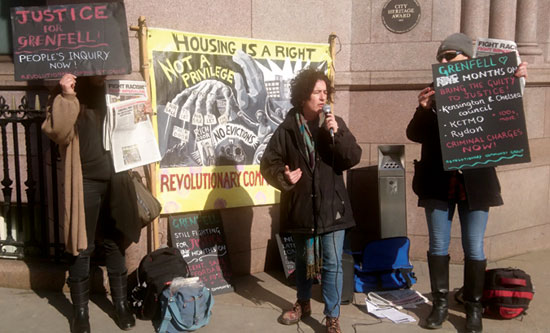
Nearly a year after the fire at Grenfell Tower in west London which killed at least 72 people, the inquiry into the disaster finally began hearing evidence in early June. As the firefighters involved in battling the blaze have begun to give oral, written and video evidence, their powerful and anguished testimony has given the lie to blatant attempt to shift public perception of blame for the deaths away from the guilty and onto them.
A toxic ‘exposé’ by journalist Andrew O’Hagan in the London Review of Books on 30 May* was eagerly seized upon by the right-wing press: the Daily Mail described the response of firefighters as ‘riddled with blunders’, saying the failure to evacuate the building for two hours after the fire started had cost lives. The police said the London Fire Brigade could face health and safety charges.
This drip-drip-drip feed of accusations has rightly been rejected by the Fire Brigades Union – as its head, Matt Wrack, put it: ‘The building was wrapped in petrol. Where’s the focus on deregulation and a criminal complacency with public safety?’ The long-standing ‘stay-put’ policy for high-rise fires is based on the notion of compartmentalisation – that every aspect of a building is guaranteed to ensure that a fire can be contained in a single dwelling for long enough for the fire services to put it out and make the building safe. The evidence provided by expert witnesses at the start of this phase of the inquiry made it clear that every aspect of Grenfell Tower had been refurbished in a ‘culture of non-compliance’ with this policy. The long, long list of failings includes:
- cladding that had never been subjected to adequate fire testing and was ‘non-compliant with the fundamental requirements of building regulations’;
- flammable materials used in window frames and kitchen vents;
- more than 100 fire doors that did not meet regulatory standards;
- no fire alarm, no sprinklers;
- inadequate access for emergency service vehicles around the tower;
- a fire lift that was not functioning and could not be used by the fire service when they arrived;
- a failure of the ventilation system, allowing thick black smoke to clog the stairway;
- a dry-rise system that was inadequate for a building of Grenfell Tower’s height, meaning that there was insufficient water pressure for hoses to be effective on the higher floors.
This lethal combination created a fire that leapt from a fourth-floor window to the top of the building within 20 minutes, burning at temperatures of over 1,000 degrees. None of the firefighters who attended the blaze, including many with decades of experience, had ever seen anything like it. As massive chunks of burning debris rained down around them ‘like meteorites’, they described the scene as ‘armageddon’. The Commissioner of the London Fire Brigade, Dany Cotton, said: ‘I have never seen a building where the whole of it was on fire. Nobody has ever seen it. It was so alien to anything I had ever seen.’ Yet despite these conditions, firefighters risked their lives, breaching protocol again and again to ferry residents to safety, often giving them their own breathing apparatus.
So let’s be clear: responsibility for the deaths at Grenfell lies squarely with those who created this death trap: KCTMO, the management organisation that oversaw the cladding of a building with untested materials that burned in seconds; the local Kensington and Chelsea council that enabled the cut-price refurbishment to go ahead; the architects, manufacturers and suppliers all down the chain who turned the building into a tinderbox. And successive governments, Conservative and Labour, who have forced through the deregulation and privatisation of fire safety measures for decades.
More than a year after the fire, the police have carried out just three interviews under caution, possibly relating to corporate manslaughter. No arrests have been made. Meanwhile they have been far more assiduous in pursuing and prosecuting cases of low-level fraud against those pretending to be survivors.
At the same time, a Freedom of Information request by The Independent has shown that there are 133 council homes lying empty in the borough of Kensington & Chelsea – half of them for more than six months. In addition to this number, 200 of the 307 homes purchased by the council to house Grenfell survivors remain empty, because they are too dilapidated, cramped or otherwise unfit to be used. As well as the 129 Grenfell households still waiting for permanent homes – including 70 in emergency accommodation – one in seven families in the borough is homeless. The fight for justice after Grenfell must also be a fight for decent housing for all those in the borough who need it.
Cat Allison
Fight Racism! Fight Imperialism! 265 August/September 2018
* See www.revolutionarycommunist.org/britain/housing-and-welfare/5264-andrew-o-hagan-s-grenfell-novella-truly-a-class-act




